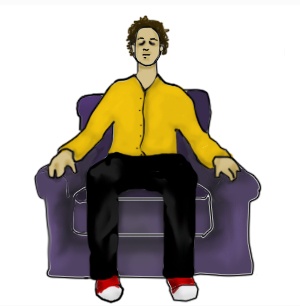Mindfulness for Physical Pain

Mindfulness is not like traditional painkillers, which are intended to dull or eliminate pain. While many experts recommend mindfulness-based practices to manage pain, the goal of those practices is typically not to remove pain entirely, but to change your relationship with it so that you are able to experience relief and healing in the middle of uncomfortable physical sensations.
Pain is a complex experience
The way you experience pain is affected by many factors in addition to pain intensity, such as your emotional state (“I am angry that I am feeling this way”), beliefs about pain (“This pain means there’s something seriously wrong with me”), expectations (“These painkillers aren’t going to work”), and environment (“I don’t have anyone to talk to about how I feel”).
In fact, pain is generally recognized to be associated with three major components:
- Physical sensations
- Emotional response to the sensations
- Social effects of the experience
Mindfulness can help you tune into the difference between these three experiences, making it possible to reduce the suffering associated with pain without necessarily reducing the severity of the pain itself. It can also help you approach your pain with less fear and more acceptance, allowing you to live life fully, even though you have pain.
A gap between the hype and the actual research
You may have seen articles claiming that “mindfulness cures headaches” or “meditation is more effective than drugs.” It’s good to be skeptical of such bold claims, which often overlook the complexities of the actual research studies and what they really show.
Mindfulness can be difficult to study because it is hard to measure how mindful someone is being. We also still don’t know how much instruction and practice is enough, or whether different formats (in person or by computer) affect people differently.
Consider these reviews of chronic-pain conditions
Fibromyalgia
Two reviews (2013 and 2015) revealed low-quality evidence for improvement of quality of life and pain after Mindfulness Based Stress Reduction (MBSR), when compared to usual care.
Low back pain:
A 2012 review found “inconclusive evidence” of MBSR’s impact on pain intensity or disability in chronic low-back pain—though they did find “limited evidence that MBSR can improve pain acceptance.”
Musculoskeletal and other pain
A 2014 review in the Journal of the American Medical Association found moderate evidence that Mindfulness Based Stress Reduction reduces pain severity, but the degree of relief varied across conditions.
The relief was strongest for those with irritable bowel and other visceral pain. These conclusions are likely to change as new high-quality research emerges. For instance, new studies for people with back pain have found that MBSR can improve function and pain compared to usual care or information, and produce results similar to those with commonly used psychological treatment.
As you can see, the research on mindfulness for pain reduction is mixed. This is largely because there has not been enough good research done to make statements about its effectiveness. As more high-quality research is performed, we will continue to learn more about the role mindfulness can play in helping people manage and approach their pain
Mindfulness can improve the psychological experience of pain
 Mindfulness Based Stress Reduction, pioneered by Jon Kabat-Zinn, is one of the most widely researched form of mindfulness practices for pain. You’ll notice it’s not called Mindfulness Based Pain Reduction. Rather, Kabat-Zinn found that when patients with chronic pain are able to uncouple their response to pain from the actual physical sensations, they are able to form a healthier response and, in turn, suffer less.
Mindfulness Based Stress Reduction, pioneered by Jon Kabat-Zinn, is one of the most widely researched form of mindfulness practices for pain. You’ll notice it’s not called Mindfulness Based Pain Reduction. Rather, Kabat-Zinn found that when patients with chronic pain are able to uncouple their response to pain from the actual physical sensations, they are able to form a healthier response and, in turn, suffer less.
As such, many of the studies that explore mindfulness and pain focus on the ways that mindfulness can improve quality of life and psychological distress associated with pain, rather than the intensity of the sensations of pain itself. Here are some examples of their findings, which constitute a moderate level of evidence:
- A 2011 review found MBSR as effective as cognitive behavioral therapy in reducing depression and anxiety for patients coping with chronic pain (Veehof, et al).
- A 2013 review demonstrated that while expert meditators report the same pain intensity as non-meditators, they experience reduced unpleasantness (Lutz, et al).
- A 2012 review of people with lower-back pain found limited evidence that MBSR can improve pain acceptance (Cramer, et al).
How mindfulness may help with the psychological experience
Mindfulness may improve the psychological experience of pain by:
- Decreasing repetitive thinking and reactivity
- Increasing a sense of acceptance for unpleasant sensations
- Improving emotional flexibility
- Reducing rumination and avoidant behaviors
- Enhancing self-compassion
- Increasing a sense of acceptance for the present moment
- Inducing the relaxation response and decreasing stress
Mindfulness practices may reduce pain intensity
There is limited (but perhaps emerging) evidence that there may be a link between mindfulness practice and pain intensity.
Researchers are exploring many ways to test pain sensitivity, from administering electrical shocks or extreme cold before and after mindfulness training, to using neuroimaging studies of the brains of long-term Zen meditators.
Reiner’s 2013 systematic review reports that most studies do show a positive connection between mindfulness-based practices and a significant reduction of pain intensity, especially among those who are experiencing clinical pain (i.e., pain from a diagnosis, rather than a laboratory-induced electrical shock). However, the research in this area is limited.
Two additional reviews also found moderate evidence that Mindfulness Based Stress Reduction reduces pain severity, although the degree of relief varied and was not considered significant for some conditions (Goyal), and one focused on fibromyalgia specifically (Lakhan).
In short, while a body of evidence that mindfulness has a direct impact on the intensity of the pain experience may be emerging, the research is still somewhat limited.
Try it out!
The best way to explore whether mindfulness can help improve your pain is to try it out for yourself. Here are two strategies:
- Tune into the physical sensations, not the thoughts about pain.
- Experiment with using the word “discomfort” instead of “pain.”
Other Techniques to Try When Working with Pain
- Try a Guided Meditation during an episode of discomfort. A good one to start with is Meditation for Working with Difficulties, which is a free guided meditation offered by the UCLA Mindful Awareness Research Center.
- You might want to experiment with different meditations. For some people, focusing on the breath might be helpful, for others, a loving-kindness meditation might work better. You can also use Google to find meditations specific to your condition and see if they are helpful.

Mindfulness and chronic pain
Jon Kabat-Zinn describes how mindfulness can help with chronic pain.
Other resources

The Earl E Bakken Center for Spirituality & Healing (the producer of this website) offers a wealth of workshops, classes, guided meditation sessions, and retreats on mindfulness, many of which are fully online and free.
Bawa, F.L., Mercer, S.W., Atherton, R.J., Clague, F., Keen, A., Scott, N.W., et al. Does mindfulness improve outcomes in patients with chronic pain? Systematic review and meta-analysis. Br J Gen Pract;65(635), 387-400.
Cherkin, D.C., Sherman, K.J., Balderson, B.H., Cook, A.J., Anderson, M.L., Hawkes, R.J., et al. (2016). Effect of Mindfulness-Based Stress Reduction vs cognitive behavioral therapy or usual care on back pain and functional limitations in adults with chronic low back pain: A randomized clinical trial. JAMA; 315(12), 1240-9.
Chiesa, A., Serretti, A. (2011). Mindfulness-based interventions for chronic pain: A systematic review of the evidence. J Altern Complement Med;17(1), 83-93.
Cramer, H., Haller, H., Lauche, R., Dobos, G. (2012). Mindfulness-based stress reduction for low back pain. A systematic review. BMC Complement Altern Med;12, 162.
Goyal, M., Singh, S., Sibinga, E.M., Gould, N.F., Rowland-Seymour, A., Sharma, R., et al. (2014). Meditation programs for psychological stress and well-being: a systematic review and meta-analysis. JAMA Intern Med; 174(3), 357-68.
Hempel, S., Taylor, S.L., Marshall, N.J., Miake-Lye, I.M., Beroes, J.M., Shanman, R., et al. (2014). Evidence map of mindfulness. Washington (DC): Department of Veterans Affairs (US); VA Evidence-based Synthesis Program Reports. VA-ESP Project #05-226.
Lakhan, S.E., Schofield, K.L. (2013). Mindfulness-based therapies in the treatment of somatization disorders: A systematic review and meta-analysis. PloS one;8(8), 71834
Lauche, R., Cramer, H., Dobos, G., Langhorst, J., Schmidt, S. (2013). A systematic review and meta-analysis of mindfulness-based stress reduction for the fibromyalgia syndrome. J Psychosom Res;75(6), 500-10.
Morone, N.E., Greco, C.M., Moore, C.G., Rollman, B.L., Lane, B., Morrow, L.A., et al. (2016). A mind-body program for older adults with chronic low back pain: A randomized clinical trial. JAMA Intern Med; 176(3), 329-37.
Reiner, K., Tibi, L., Lipsitz, J.D. (2013). Do mindfulness-based interventions reduce pain intensity? A critical review of the literature. Pain Med;14(2), 230-42.
Theadom, A., Cropley, M., Smith, H.E., Feigin, V.L., McPherson, K. (2015). Mind and body therapy for fibromyalgia. Cochrane Database Syst Rev. 9;4.
Other Physical Symptoms
Abbott, R.A., Whear, R., Rodgers, L.R., Bethel, A, Thompson Coon, J., Kuyken, W., et al. (2014). Effectiveness of mindfulness-based stress reduction and mindfulness based cognitive therapy in vascular disease: A systematic review and meta-analysis of randomised controlled trials. J Psychosom Res;76(5), 341-51.
Aucoin, M., Lalonde-Parsi, M.J., Cooley, K. (2014). Mindfulness-based therapies in the treatment of functional gastrointestinal disorders: A meta-analysis. Evid Based Complement Alternat Med. doi: 10.1155/2014/140724. Epub 2014 Sep 11. Review. PubMed PMID: 25295066; PubMed Central PMCID: PMC4177184.
Gotink, R.A., Chu, P., Busschbach, J.J., Benson, H., Fricchione, G.L., Hunink, M.G. (2015). Standardised mindfulness-based interventions in healthcare: An overview of systematic reviews and meta-analyses of RCTs. PLoS One. 16;10(4).
Merkes, M. (2010). Mindfulness-based stress reduction for people with chronic diseases. Aust J Prim Health;16(3), 200-10.